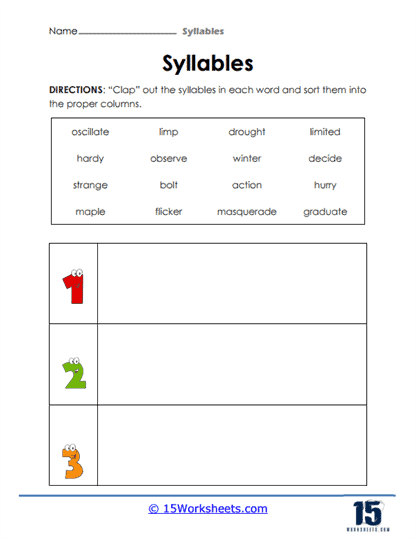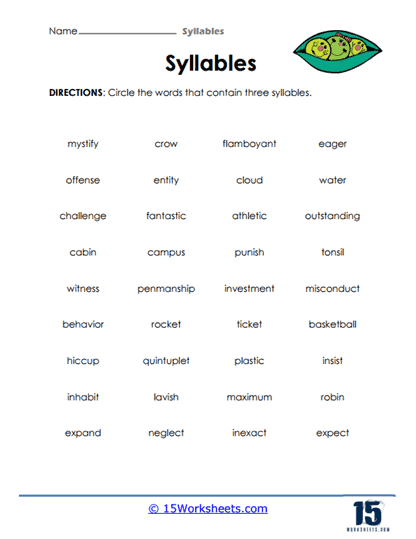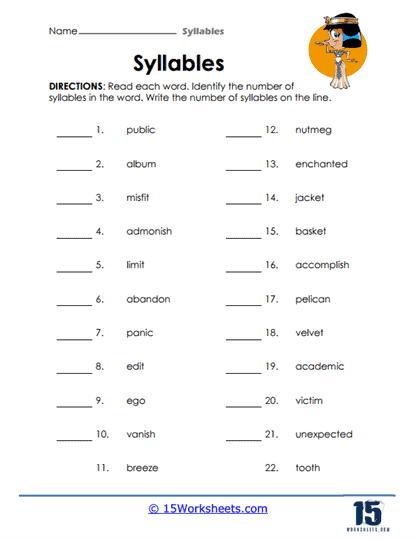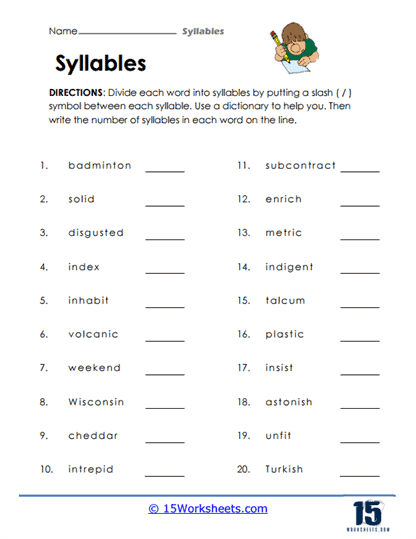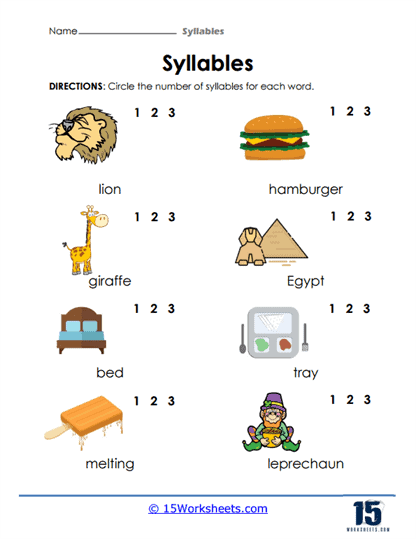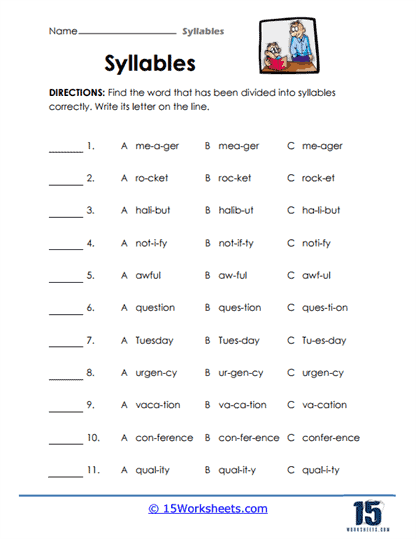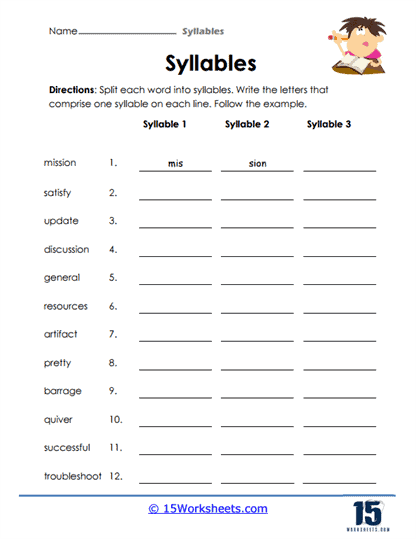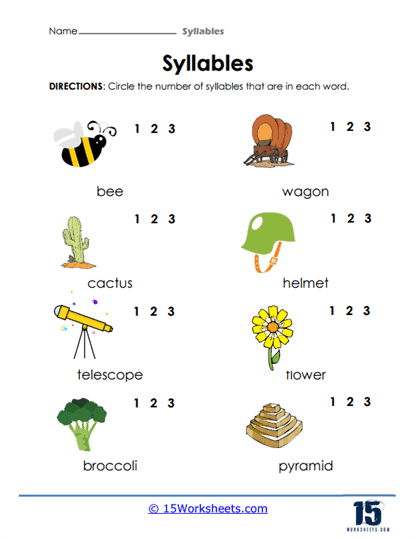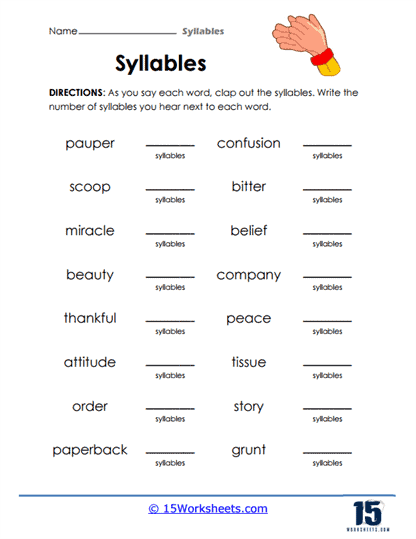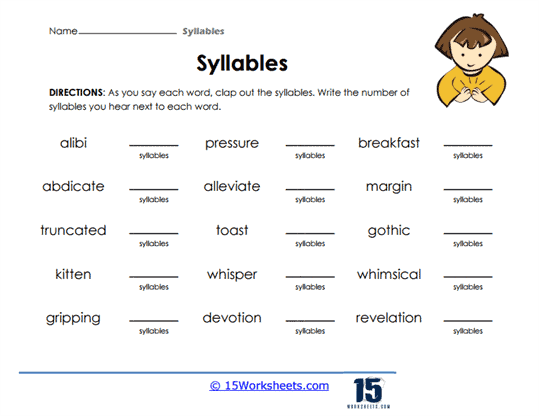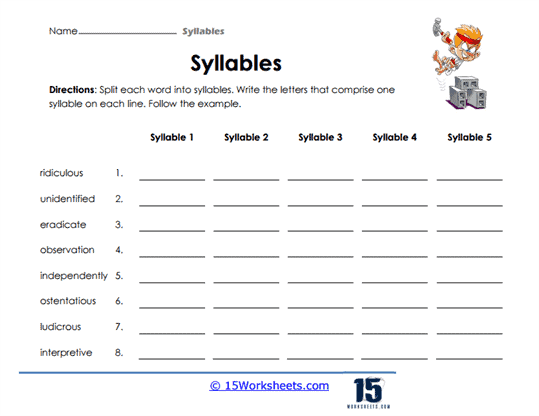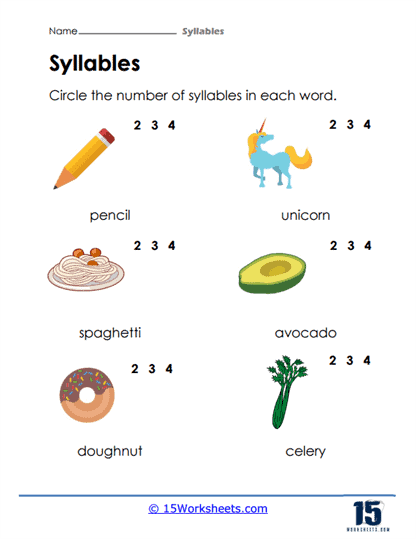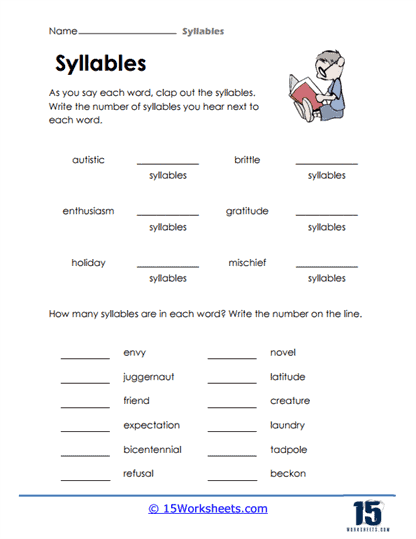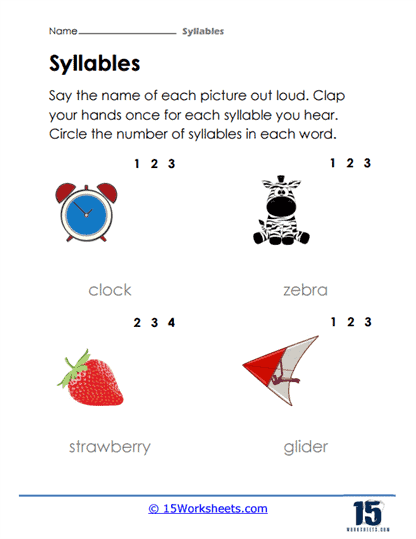Syllables Worksheets
All About These 15 Worksheets
This collection of worksheets will help students break down words into smaller, manageable units of sound, known as syllables. Understanding syllables is a crucial part of phonics, reading, and language arts because it helps students decode and pronounce words correctly, especially more complex or unfamiliar vocabulary. By learning how to identify and count syllables, students improve their overall reading fluency, making it easier for them to read aloud, comprehend what they’re reading, and develop better spelling skills. These worksheets are beneficial for learners of all ages, from early readers who are just starting to grasp the basics of phonics to older students working on more advanced language arts skills.
Syllables worksheets are particularly helpful because they provide a structured approach to understanding the rhythm and structure of words. Many students struggle with long or unfamiliar words, and learning how to break them down into syllables makes these words less intimidating. For example, the word “impossible” may seem overwhelming at first, but when broken down into its syllables-im-pos-si-ble-it becomes much easier to pronounce and understand. This skill becomes essential as students progress to more complex texts in higher grade levels, where multi-syllable words are common. In addition to helping with pronunciation, mastering syllables also aids in spelling, as students can use syllable patterns to remember how words are constructed.
In a broader context, syllables worksheets are integral to improving phonemic awareness, which is the ability to hear, identify, and manipulate individual sounds in words. This ability forms the foundation for reading success, as students who can easily recognize syllables can also better grasp spelling patterns, word stress, and rhythm in language. This phonemic awareness is especially important for English learners or students who struggle with reading, as it gives them the tools to break down difficult words and become more confident in their literacy skills.
How These Worksheets Improve Reading Skills
This series is a powerful set tools for enhancing both reading comprehension and language arts skills. By breaking words down into syllables, students gain greater control over their reading fluency. When they can recognize and decode words quickly, their reading speed and accuracy improve, which in turn leads to better comprehension. For instance, a student reading the word “independence” for the first time might find it daunting, but by identifying it as in-de-pen-dence, they can approach the word more systematically and with greater confidence. This ability to decode longer words opens the door to understanding more advanced texts, allowing students to engage more deeply with a variety of subjects.
In addition to reading fluency, syllables worksheets also strengthen students’ spelling abilities. Many spelling patterns in English follow specific syllable rules, and when students understand how syllables work, they can apply this knowledge to their spelling. For example, knowing that most English words have a single vowel sound per syllable helps students avoid common spelling mistakes, such as confusing silent letters or misplacing vowels. Furthermore, these worksheets help students understand how syllables influence word stress, which is essential for both pronunciation and understanding meaning in context. For instance, the difference between “record” as a noun (RE-cord) and “record” as a verb (re-CORD) is rooted in syllable stress, and understanding these differences is key to mastering the nuances of the English language.
They are also excellent tools for building students’ vocabulary. As they break words into syllables, students are exposed to a wider range of vocabulary, including words they might not have encountered before. Each syllable represents a building block of language, and by learning how these blocks fit together, students become better equipped to tackle new words and expand their lexicon. This is especially beneficial in academic settings, where students are required to read and understand complex terminology in subjects like science, history, and literature. By using syllables worksheets, students not only improve their word recognition but also develop a deeper understanding of how language works, which enhances both their written and spoken communication skills.
Types of Exercises
This collection worksheets come with a variety of exercises designed to reinforce students’ understanding of how syllables work in words. One common type of exercise is the syllable counting activity, where students are asked to look at a list of words and determine how many syllables each word contains. For example, students might encounter words like “dog,” “elephant,” and “fantastic,” and they will count the syllables: “dog” has one syllable, “elephant” has three, and “fantastic” has three. This activity is foundational because it helps students learn to break words into their component parts and recognize syllable boundaries.
Another type of exercise is syllable division, where students are tasked with breaking words into their syllables by placing slashes between them. For instance, students might be given the word “butterfly” and asked to divide it into syllables: but-ter-fly. This activity not only helps with pronunciation but also aids in spelling, as students learn how to segment longer words into more manageable parts. These division exercises can also include multi-syllable words that follow different syllable patterns, helping students recognize that not all words follow the same rules.
Syllable sorting is another engaging activity commonly found on these worksheets. In this exercise, students are given a list of words with varying numbers of syllables and must sort them into categories based on their syllable count. For example, students may have to sort words like “apple,” “giraffe,” “hippopotamus,” and “fish” into groups: one-syllable, two-syllable, three-syllable, or four-syllable words. This type of sorting task reinforces students’ ability to quickly identify syllable patterns and understand the structure of different words, which is crucial for reading fluency.
Some of the worksheets also incorporate more advanced exercises, such as focusing on the types of syllables (e.g., open vs. closed syllables) or identifying stressed and unstressed syllables within words. These more advanced activities help students not only with pronunciation but also with understanding word stress in sentences, which is an important skill for reading aloud or speaking with proper intonation. For instance, worksheets might challenge students to mark the stressed syllable in a word like “incredible” (in-CRED-i-ble), which aids in developing proper pronunciation skills.
These worksheets include fill-in-the-blank activities, where students are asked to complete a word based on its syllable structure. For example, a worksheet might show “_lephant” and ask students to fill in the missing syllable (“el”). These exercises are excellent for building vocabulary and reinforcing students’ ability to recognize common syllable patterns and apply them to new words.
What Are Syllables?
Syllables are units of sound that make up words. A syllable consists of a single vowel sound, with or without surrounding consonants, and is often considered the basic building block of a word. Each syllable contains one vowel sound and may include one or more consonant sounds before or after the vowel.
In English, words can have one or multiple syllables. For example:
One-syllable words – cat, dog, house
Two-syllable words – apple, happy, window
Three-syllable words – elephant, computer, umbrella
How To Teach Counting Syllables To Students
Counting syllables in words is an important skill for developing reading, spelling, and pronunciation abilities. Here are several methods to help you count syllables in words:
Clap Method – Say the word out loud and clap your hands once for each syllable you hear. Each syllable contains a distinct vowel sound, so listen for the changes in the sound as you say the word.
Chin Method – Place your hand under your chin and say the word slowly. Your chin will drop once for each syllable in the word, as it moves when you pronounce a vowel sound.
Finger Method – As you say the word out loud, place a finger on the table for each syllable you hear. This tactile approach can help reinforce the connection between the number of vowel sounds and syllables.
Vowel Counting – Identify the vowels (A, E, I, O, U) in the word and count them. Remember that each syllable has one vowel sound. Be cautious with words that have vowel combinations, such as “boat” or “train,” as they often represent one syllable despite having two vowels.
Dividing the Word – Break the word into smaller chunks or segments, focusing on the vowel sounds. For example, the word “banana” can be divided into “ba-na-na,” which has three syllables.
Use a Dictionary – Many dictionaries indicate the syllable breaks in words using dots or hyphens. If you’re unsure of the number of syllables in a word, consult a dictionary to verify.
Keep in mind that counting syllables is not always straightforward, as certain words may have silent vowels or adjacent vowel sounds that create a single syllable (known as diphthongs). With practice and by employing these methods, you can improve your ability to count syllables in words and enhance your language skills.
The Importance of Syllables
Understanding and mastering syllables is a fundamental aspect of literacy development that cannot be overstated. Syllables, the individual units of sound within words, are the building blocks of language. For students to excel in reading, spelling, and comprehension, they must first develop a strong grasp of how syllables function in words. This collection of syllables worksheets provides a structured, engaging way for students to enhance their phonological awareness, reading proficiency, spelling competence, and vocabulary growth. By breaking words down into manageable sound units, these worksheets offer a hands-on approach to language learning, making it easier for students to decode unfamiliar words and improve their overall literacy skills.
One of the key reasons why syllables are so important is their role in developing phonological awareness. Phonological awareness refers to the ability to recognize and manipulate the sounds and structures within language, and it is a critical precursor to reading and writing. Syllable awareness is a vital part of this skill set. Through activities that encourage students to count, segment, and blend syllables, the worksheets help students become more attuned to the sounds that make up words. For example, a worksheet may ask students to clap out the syllables in words like “banana” (ba-na-na) or “computer” (com-pu-ter), helping them to better understand word structures. This awareness is crucial, as it forms the foundation for decoding and encoding words, making the transition to fluent reading much smoother.
Beyond phonological awareness, syllable recognition plays a significant role in reading proficiency. The ability to break words down into syllables is essential for decoding unfamiliar or longer words. For example, a student encountering the word “incredible” for the first time may feel overwhelmed by its length. However, by breaking it into its syllables-“in-cre-di-ble”-the word becomes easier to tackle. This approach not only helps students read more fluently but also builds their confidence, as they develop strategies to approach challenging vocabulary. The worksheets provide exercises such as syllable division and word sorting, where students practice dividing words into syllables or categorizing words based on the number of syllables they contain. These activities give students the tools they need to become proficient readers, capable of decoding new words with ease.
Spelling competence is another area where mastering syllables proves invaluable. Many spelling patterns in English are based on syllables, and by understanding these patterns, students can significantly improve their spelling skills. For example, knowing that most syllables in English contain a single vowel sound helps students avoid common spelling errors. A worksheet may guide students through exercises where they identify closed syllables (syllables that end in a consonant) and open syllables (syllables that end in a vowel) in words like “rabbit” or “hero.” By recognizing these syllable types and patterns, students become better equipped to spell words correctly, even if they haven’t encountered them before. Additionally, as students practice breaking down words into syllables, they internalize the structure of language, making it easier for them to remember the correct spelling of challenging words.
Another crucial benefit of working with syllables is the opportunity it provides for vocabulary growth. When students learn how syllables work, they are exposed to a broader range of words, as they begin to understand the structure of more complex vocabulary. For example, as students break down multisyllabic words like “celebration” or “imagination,” they are not only improving their pronunciation but also expanding their understanding of the meaning and usage of these words. This expanded vocabulary is essential for reading comprehension, as students are better able to understand and engage with the texts they encounter. Vocabulary-building activities within the worksheets, such as matching words to their syllable patterns or using multisyllabic words in sentences, further reinforce this growth, helping students to integrate new words into their everyday language use.
These syllables worksheets are particularly helpful because they provide a hands-on, engaging approach to learning. Unlike passive reading exercises, syllable activities require students to actively participate in the learning process. For example, a worksheet might challenge students to segment words into their syllables using visual aids, such as pictures or charts, to make the experience more interactive. Another activity might involve students clapping or tapping out the syllables in words, turning language learning into a physical, rhythmic exercise. These engaging methods not only hold students’ attention but also make the learning process more memorable. As students become more confident in their ability to recognize and use syllables, they build a stronger foundation for all aspects of language arts.
The variety of exercises and problems found in these syllables worksheets ensures that students develop a well-rounded understanding of how syllables function in language. One common exercise is syllable counting, where students are asked to count the number of syllables in different words. For example, a worksheet might present a list of words-such as “dog,” “elephant,” and “beautiful”-and ask students to count how many syllables each word contains (one, three, and three syllables, respectively). This foundational activity helps students recognize the structure of words and prepares them for more advanced tasks.
Another common exercise is syllable division, where students break words into their individual syllables. For instance, students might encounter the word “unbelievable” and be asked to divide it into syllables: “un-be-liev-a-ble.” This exercise not only aids in reading fluency but also helps with spelling, as students learn to recognize common syllable patterns in words. Additionally, students may be tasked with sorting words based on the number of syllables they contain, reinforcing their understanding of syllable structure through categorization.


